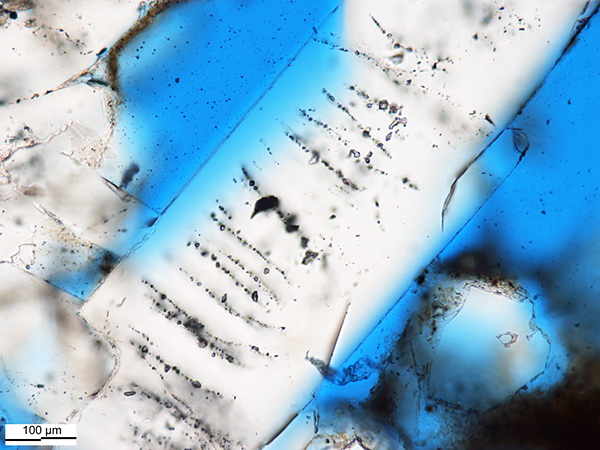András Fall

“I always try to hit the bulls eye. Analyzing (hopped) fluids at the same time usually helps.”
About András Fall
András Fall joined the Bureau of Economic Geology as a Postdoctoral Fellow in 2008 . He earned his M.Sc. and Ph.D. in Geosciences from Virginia Tech and also holds an M.Sc. in Geology from the University of Bucharest. He has received recognition from AAPG and SEPM for Excellence in Technical Presentation and is the recipient of the C.G. Tillman Teaching Excellence Award from Department of Geosciences at Virginia Tech. Now a Research Associate with the Bureau's Fracture Research and Application Consortium (FRAC), Fall has done extensive work in fracture studies, including research in fluids in diagenetic and hydrothermal systems, fluid inclusion techniques, fracture analysis, structural diagenesis, Raman spectroscopy, and unconventional hydrocarbon reservoirs.
What are your current research activities?
My current interests focus on understanding the interaction of geochemical and mechanical processes in sedimentary rocks. My research combines low-temperature geochemistry (fluid inclusions and hydrothermal experiments) and fracture analysis addressing fracture formation and cementation mechanisms, fracture timing, and pore-pressure evolution in sedimentary basins and in fractured and unconventional reservoirs.
What excites you the most about your current research?
Fluid inclusions are a key to unlocking the history of fracture growth. Our recent fluid-inclusion studies on crack-seal fracture cements that formed during fracture opening have provided age constraints on fracture formation based on correlations of temperature trends obtained using fluid-inclusion microthermometry of crack-seal fracture cement with independently derived temperature-history models in various economically significant basins. Raman spectroscopic measurement of the inclusions also allowed the pressure history to be inferred in many cases.
What is the desired outcome of your research?
Our desired outcome is to provide simple and widely used tools to enhance our knowledge of the chemical and mechanical interactions in sedimentary basins, and to improve basic fluid-inclusion methods as a geochemical tool to understand the history of geofluids.
What do you need in order to make your research efforts more successful?
I need more time—and better management of my time—to do more experimental work, using our hydrothermal setting, in support of theoretical models of fracture opening, propagation, and cementation developed by our research group.

Fracture-wall-parallel trails of hydrocarbon gas inclusions in a quartz cement bridge in a tight-gas sandstone from the Piceance Basin, Colorado. For details see the referenced GSA Bulletin paper.
What are your latest papers/publications, and what is most exciting to you about them?
One of our papers, in press now, describes previously enigmatic features in quartz cement bridges in fractures: trails of fracture-wall-normal fluid inclusions that coincide with Dauphiné twin boundaries. These features provide a potential tool to estimate paleostrain and stress in sedimentary rocks; using our fluid-inclusion techniques, we can potentially determine the timing of such deformation features.
A soon-to-be-submitted paper revisits the use of fluid-inclusion assemblages while conducting a fluid-inclusion study that will help in better understanding microthermometric data obtained from fluid inclusions, independent of the geologic environment in which the study is performed.
Who will benefit from your latest paper or publication?
Anybody in either academia or industry who would use fluid inclusions to obtain thermal data or timing constraints for a specific geologic event in their study area, e.g., fracture formation and cementation, or hydrocarbon generation and migration.
What was your most exciting past paper or publication, and why?
Our Fall et al. (2015) paper published in the GSA Bulletin, because our fracture-cement and fluid-inclusion observations provided evidence for the driving mechanisms and timing of natural hydraulic fracturing in a tight-gas sandstone reservoir (Piceance Basin). This process is possibly comparable to the charge and fracturing mechanisms of other similar reservoirs.
Fall, A., Eichhubl, P., Bodnar, R. J., Laubach, S. E., and Davis, J. S., 2015, Natural hydraulic fracturing of tight-gas sandstone reservoirs, Piceance Basin, Colorado: Geological Society of America Bulletin, v. 127, no. 1–2, p. 61–75, doi: 10.1130/B31021.1.
Who are the types of research partners you are seeking?
Researchers with a good understanding of low-temperature geochemistry who recognize the value of the methods used in our labs and would implement them in their study areas, as well as workers who have a potential for collaborating in our hydrothermal experiments focusing on fracture-cement precipitation and dissolution.
What are the desired relationships, expertise, or skills that could be brought in to benefit your research?
We recently added staff at the RSA level to help us with our load of industry case studies that involve fluid-inclusions analysis. This will certainly help me to focus more on the experimental work. I would also value a collaboration with researchers with a strong experimental background in both high- and low-temperature aqueous geochemistry.
What have been recent successes associated with your research (grants, awards, patents, etc.)?
I will benefit from the recent renewal of our group’s DOE Basic Energy Sciences research grant— focusing on predicting fracture-porosity evolution in sandstone—that has support built in for the experimental fracture-diagenesis work.
The abovementioned Fall et al. (2015) paper was recently awarded the 2016 Tinker Family BEG Publication Award “in recognition of exemplary publication of scientific or economic impact.”
What is the geographic location of your research?
My recent research locations include the United States (various basins in Texas, Colorado, and Wyoming), as well as Argentina and Bolivia.